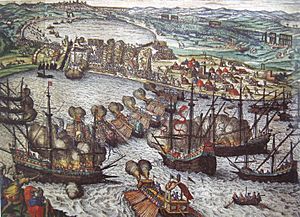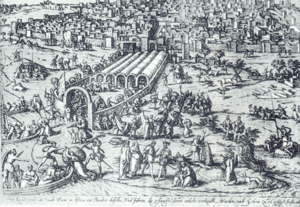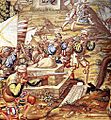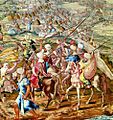Conquest of Tunis (1535) facts for kids
Quick facts for kids Conquest of Tunis |
|||||||||
|---|---|---|---|---|---|---|---|---|---|
| Part of the Ottoman–Habsburg wars and the Ottoman–Portuguese conflicts |
|||||||||
 Attack on La Goletta, with Tunis in the background.  Entry of Charles V, Holy Roman Emperor, into Tunis in 1535. |
|||||||||
|
|||||||||
| Belligerents | |||||||||
|
|||||||||
| Commanders and leaders | |||||||||
| Strength | |||||||||
|
Total men: 30,000–60,000
Total ships: 398 |
|||||||||
| Casualties and losses | |||||||||
| Unknown: Many fell to dysentery | 30,000 Muslim civilians killed 9,000 Christians freed |
||||||||
The Habsburg Empire of Charles V and its allies took control of Tunis in 1535. They won the city from the Ottoman Empire. This event was a major part of the Ottoman–Habsburg wars.
Why the Battle Happened
In 1533, Suleiman the Magnificent, the leader of the Ottoman Empire, told Hayreddin Barbarossa to build a huge war fleet. Barbarossa was a famous Ottoman admiral. They built 70 galleys (large ships powered by oars) in just one winter. Many people were forced to row these ships.
With this new fleet, Barbarossa attacked parts of Italy. Then, on August 16, 1534, he captured Tunis. He removed the local ruler, Muley Hasan, who had been loyal to Spain. By taking Tunis, Barbarossa created a strong naval base. This base could be used to launch more attacks in the region, including on nearby Malta.
Charles V, the powerful ruler of the Habsburg Empire, decided to fight back. He gathered a very large army of about 30,000 soldiers. He also had 74 galleys and 300 sailing ships. One of his most powerful ships was the Portuguese galleon São João Baptista.
This military effort was very expensive for Charles V. It cost about 1,000,000 ducats (a type of gold coin). This was similar to the cost of his other big campaigns. A lot of the money came from gold and silver brought from the New World (the Americas). This treasure was taken by Francisco Pizarro from the Inca king Atahualpa.
Charles V asked Francis I, the King of France, for help. But Francis I refused. He said he had a three-year truce (a peace agreement) with Barbarossa. Francis I was also talking with Suleiman the Magnificent about working together against Charles V. However, Francis I did agree not to fight other Christian groups during Charles V's expedition.
The Battle of Tunis
Charles V's fleet sailed from Sardinia. It was a large group of Catholic forces, protected by a fleet from Genoa. On June 1, 1535, Charles V's forces destroyed Barbarossa's fleet.
Next, they attacked La Goletta, a strong fort protecting Tunis. The siege was difficult, but Charles V's forces succeeded in capturing it. During this attack, the Portuguese galleon São João Baptista played a key role. It broke the chains that blocked the harbor entrance. Then, it fired its cannons on La Goletta.
After the battle, Spanish soldiers found cannonballs with the French fleur-de-lis (a French symbol) mark. This showed that France and the Ottoman Empire were working together.
Sadly, many civilians in Tunis lost their lives during the capture of the city. An estimated 30,000 people died. Barbarossa managed to escape to Algiers with thousands of Ottoman soldiers.
After the victory, Muley Hasan was put back on his throne as the ruler of Tunis. The smell from the many bodies was so bad that Charles V soon left Tunis. He moved his camp to Radès.
This victory showed how powerful the Habsburg Empire was at the time. Charles V controlled large parts of southern Italy, Sicily, Spain, the Americas, Austria, the Netherlands, and lands in Germany. He was also the Holy Roman Emperor, which gave him power over much of Germany.
The Ottoman defeat in Tunis led to a formal alliance between the Ottoman Empire and France. They joined forces against the Habsburg Empire. An ambassador named Jean de La Forêt was sent to Constantinople. He became the first permanent ambassador at the Ottoman court.
Charles V celebrated his victory in a grand way, like the ancient Roman triumphs. He held celebrations first in Sicily and then in Rome on April 5, 1536. To make the city safer, the Spanish governor of La Goulette, Luys Peres Varga, strengthened the defenses of Chikly island in the lake of Tunis between 1546 and 1550.
What Happened Next
After escaping Tunis, Barbarossa went to the harbor of Bône. A fleet was waiting for him there. From Bône, he sailed and attacked Mahón. He took 6,000 people as slaves and brought them to Algiers.
The Ottomans later recaptured Tunis in 1569. Spain took it back in 1573 under John of Austria. But Spain lost it again in 1574. After this, the Ottoman governors of Tunis were semi-independent rulers called beys. They often acted as privateers, attacking Christian ships. This raiding in the Mediterranean Sea continued for a long time. It only stopped when the Barbary pirates were defeated in the early 1800s.
Later, a French invasion led to the creation of French Algeria in 1830. France then established a protectorate over Tunisia in 1881.
Gallery
-
Imperial troops in the conquest of Tunis, 1535, Jan Cornelisz Vermeyen.
See also
 In Spanish: Jornada de Túnez para niños
In Spanish: Jornada de Túnez para niños








